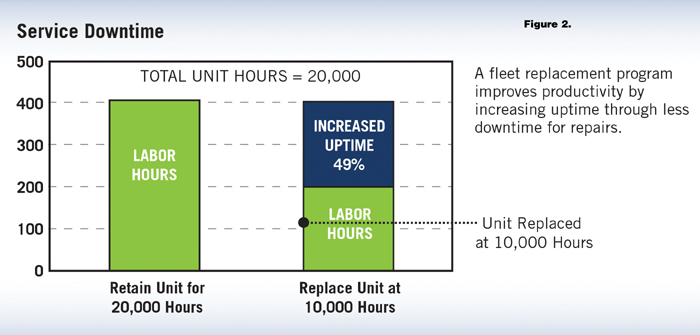(Editor’s Note: The following article is based on a white paper titled ‘Optimizing Your Fleet: A Business Case for thriving in an Economic Downturn.’ The white paper was produced for www.trucktruth.com, a Web site of forklift manufacturer Hyster Company. The white paper is 10 pages long; this article focuses only on a portion of the white paper.)
Replacing lift trucks based on optimum life is one of the key pillars of a good fleet optimization model. Sound fleet assessment surveys will evaluate and recommend opportunities for right-sizing your fleet by retiring old trucks and replacing some high operating hour trucks with new trucks.
There are several benefits of retiring a lift truck with high operating hours. The accompanying chart (Figure 1) suggests there is an economical life to a material handling asset. As the asset begins to reach high operating hours, the unscheduled downtime (and associated maintenance costs) can begin to escalate exponentially. It is at this point when a business starts to throw good money after bad. The optimum or economical life of an asset can vary by type of truck, its operating environment (application), and estimated annual usage.
Taking it a step further is the additional consideration of lost productivity caused by more frequent downtime as the lift truck asset ages. Figure 2 estimates the reduction in service labor hours by replacing a lift truck at 10,000 hours versus 20,000 hours. This chart suggests an estimated 50% improvement in uptime can be realized.
The cost of maintaining an asset and the subsequent cost of extensive downtime should be key considerations in an asset replacement program to ensure optimal cost of operation. It is important that these plans are implemented to guide asset replacement decisions during times of economic downturn as well as prosperity.
Studies have shown that many businesses that have yet to subscribe to a fleet management program do not have a fleet optimization model in place. This is largely due to the lack of valuable information necessary to support such a model.
Replacing units based on their optimum life and measuring lost productivity on trucks with high operating hours can help support a fleet optimization model. Right-sizing and re-deployment of trucks should also be taken into consideration when developing a fleet optimization model.
Right-sizing a company’s equipment base can be the most challenging of the two options. It can have a negative effect on productivity if an aggressive approach is taken. Right-sizing equipment can also have an impact on the number of operators you employ, and opportunities for reducing or re-deploying your workforce can be of added benefit.
Right-sizing the equipment base is also intended to remove non-productive units. One of the key measurements for right-sizing your fleet is utilization. In one example, a fleet of 156 trucks was being utilized simultaneously 70% of the time, suggesting opportunities either for reducing the fleet size or capitalizing on model standardization. It is typically a fleet program manager’s responsibility to propose these recommendations.
Re-deployment of equipment can be an effective alternative for balancing utilization either within a facility or at other locations. Under-utilizing an asset can lead to over-paying for maintenance, assuming the truck is on a fixed monthly maintenance program. As monthly payments for full maintenance are calculated on anticipated hours used over a term, an under-utilized asset (which did not reach the anticipated hours of use) has, in essence, overpaid for full maintenance coverage. Conversely, an over-utilized truck (above the estimated annual usage) could be charged a premium for those hours above the annual estimate. In this case, a utilization assessment (and subsequent billing) could occur on an annual basis. To minimize these occurrences, re-deployment recommendations are made by fleet account managers.
Close monitoring of a lift truck fleet (and operators) is a key driver to maximizing productivity and to help ensure operational cost containment. While there are certain levels of truck and operator monitoring that can be handled by human resources, i.e., hour meter collection for cost per hour and utilization calculations, there are basic telemetry solutions that can compete economically in this arena when compared with the cost of man-hours tied to this routine, labor-intensive process.
However, there are certain performance measurements surrounding operator productivity that cannot be either easily monitored or accurately measured through human resources. While utilization percentages can be used as actionable data, it may not deliver the desired performance objective.
Monitoring utilization may not provide you meaningful data as to how many loads the operator moved that day. Installing load sensors on the truck, though, will provide a more accurate measurement.
As you look for telemetry solutions to help compress your operational costs and improve productivity, make sure you have the best understanding of what you want to measure — for example, motion/idle time, speed/distance, impact by operator, etc.
There are a number of fleet management tools and capabilities that can provide rapid and positive tangible results and be implemented with little or no upfront investment. Each of the areas profiled in this paper are subjects that are worthy of in-depth exploration on their own merits. The intent, however, has been to share concepts and capabilities that can be taken advantage of in the effort to reduce operational costs during these difficult economic times.
Of key importance is selecting a fleet management business partner that can take a holistic and diagnostic approach to assess your current position and provide opportunities for future savings. A fleet management partner must possess the full range of tools and capabilities for deployment within your business and be able to leverage a network of service providers that have breadth of coverage and depth of experience and skill.
The complete white paper this article is based on can be downloaded at www.trucktruth.com.





